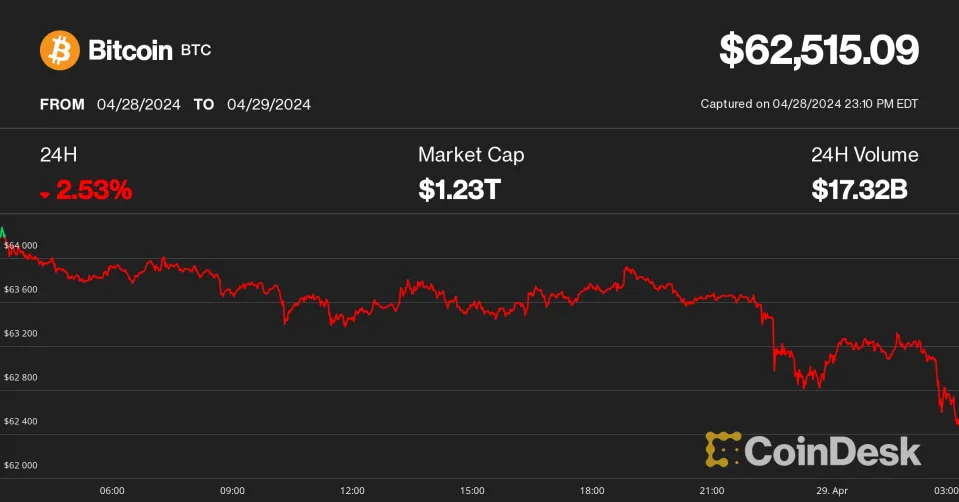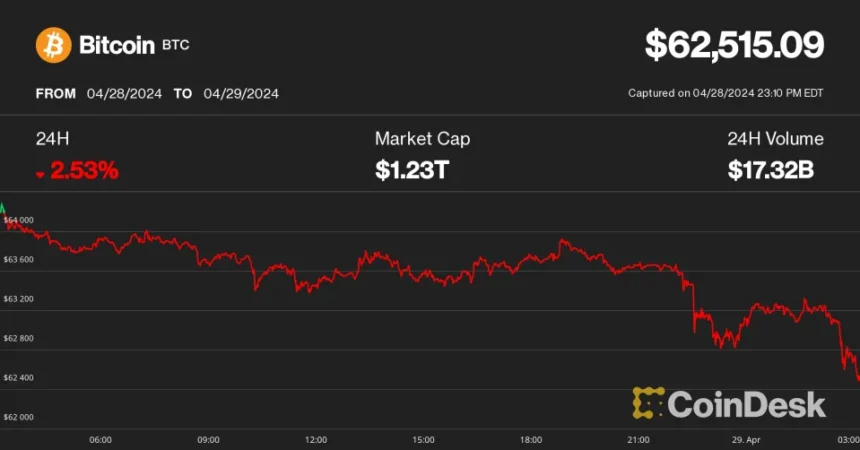Bitcoin and Ether Trade Lower as Asia Starts Week
The crypto markets are witnessing a sea of red as the new week begins, with Bitcoin and Ether trading lower amid renewed fears of stagflation in the U.S. economy. This scenario, characterized by high inflation and low growth, poses a significant threat to risk assets.
At the time of writing, Bitcoin (BTC), the flagship cryptocurrency, hovers around $62,400, marking a 2.5% decline over the past 24 hours, per CoinDesk Indices data. Ether (ETH), the second-largest crypto by market cap, is down 3% at $3,200, while the CoinDesk 20 (CD20) index, tracking the 20 most liquid digital assets, has dipped 2.6% to 2,197 points.
Bullish and Bearish Narratives in Play

The crypto market finds itself at a crossroads, with conflicting signals pointing to both bullish and bearish possibilities. On one hand, concerns about stagflation are mounting after weaker-than-expected U.S. GDP data and higher core PCE inflation. This combination could hinder the Federal Reserve’s ability to cut interest rates and stimulate the economy.
As QCP noted in a recent analysis, “The weaker than expected [U.S.] GDP print points to a more sluggish economy while the higher Core PCE warns of an inflation problem […].”
U.S. GDP growth for Q1 2024 came in at an annualized rate of 1.6%, down from 3.4% in Q4 2023. Meanwhile, the personal consumption expenditures price (PCE) index, the Fed’s preferred inflation measure, rose to a 3.4% annualized rate in Q1, indicating persistent inflationary pressures.
The likelihood of Fed rate cuts has diminished due to this stagflationary environment, with Polymarket predictions showing a 35% chance of no rate cuts and a creeping probability (29%) of a single rate cut.
Potential Upside for Risk Assets
However, there is also a bullish case to consider. QCP highlighted that U.S. Treasury Secretary Janet Yellen’s fiscal strategy could inject up to $1.4 trillion in liquidity into the financial system, boosting risk assets. This strategy involves leveraging the Treasury General Account (TGA) and the Reverse Repurchase Program (RRP).
As CoinDesk’s Omkar Godbole emphasized, the key factor to watch is the U.S. Treasury’s quarterly refunding announcement, which could impact the current TGA balance of $750 billion. This balance serves as a critical signal to financial markets about the government’s fiscal stance, influencing economic stability and growth.
Traders are also keeping an eye on the upcoming launch of Bitcoin exchange-traded funds (ETFs) in Hong Kong on April 30. However, the news that mainland Chinese investors will not be able to trade these ETFs has tempered the initial enthusiasm surrounding the launch.
Disclaimer: The content of this article is for informational purposes only. It is not intended as financial advice or investment advice. Please do your own research and consider seeking professional advice before making any financial decisions.




